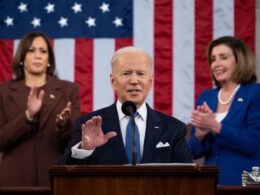NEJM
Jonathan Oberlander, Ph.D.
March 30, 2022
equipohealth
When Joe Biden campaigned to become president of the United States, he pledged to build on the Affordable Care Act (ACA), expand health insurance coverage, and control prescription-drug prices. How did the first year of his presidency live up to these promises? Although the Covid-19 pandemic has dominated much of the policymaking agenda, the Biden administration and congressional Democrats have pursued an array of health care reforms.
Biden moved quickly to reverse Trump administration policies that impeded enrollment in government health insurance programs. In February 2021, he issued an executive order rolling back the Trump administration’s expansion of the “public charge” rule that had denied legal permanent residency to immigrants who had received benefits under various government programs, including Medicaid.
Although use of Medicaid by people younger than 21 years of age didn’t count toward public-charge determinations, confusion and fear surrounding the rule suppressed enrollment in Medicaid and the Children’s Health Insurance Program (CHIP) among children in immigrant families.1 Biden’s executive order could thus increase access to insurance for members of such families.
In another reversal, the Biden administration withdrew federal waivers authorized by the Trump administration that had enabled states to establish work requirements for Medicaid enrollees. Such requirements created barriers to health coverage for low-income people — in Arkansas, 18,000 adults lost coverage during the first year after the provisions were implemented — and triggered legal battles over whether they violated Medicaid’s core objectives.2 The Biden administration’s rejection of Medicaid work-requirement waivers marks a return to federal policy that seeks to increase enrollment of eligible people in government health programs. In keeping with this goal, the administration has also revoked permission for some states to charge premiums to people enrolled in Medicaid.
The Biden administration has also opened up the ACA’s health insurance marketplace and promoted enrollment in marketplace plans. In January 2021, the administration announced a special open-enrollment period (which ultimately lasted 6 months) for the marketplace in response to the Covid-19 pandemic, while seeking to boost enrollment by means of increased outreach and advertising. In September 2021, the administration established a new, permanent special enrollment period for people with incomes below 150% of the federal poverty level.
In addition to issuing and carrying out these and other executive orders and administrative actions, the Biden administration has helped secure the enactment of major health care legislation. The 2021 American Rescue Plan Act (ARPA) made premium subsidies for purchasing ACA plans more generous for low-income people and extended subsidies to people with incomes exceeding 400% of the federal poverty level. It also offered states that hadn’t expanded Medicaid eligibility under the ACA new financial incentives to do so.3 ARPA meaningfully enhanced the ACA’s coverage policies for the first time since the landmark law’s 2010 enactment, with revisions aimed at addressing widespread affordability issues for people buying marketplace plans. These provisions will expire at the end of 2022, however, unless Congress renews them. ARPA also enabled states to extend the duration of Medicaid and CHIP postpartum coverage for low-income women from 60 days to 12 months (this provision will expire in 2027).
Beyond these reforms, though, the administration hasn’t achieved other objectives that Biden campaigned on.
There has been no movement in Congress on lowering the age of eligibility for Medicare from 65 years to 60 years.
Nor has there been any momentum toward enacting a new, Medicare-like government program (a public option) that uninsured people and those who currently have private coverage could join.
Meanwhile, the Build Back Better Act (BBBA) that passed the House in 2021 contains a number of key health policies, including provisions to extend ARPA’s changes to subsidies for ACA plans, provide fully subsidized marketplace coverage for low-income people in states that haven’t expanded
Medicaid eligibility, make federal CHIP funding permanent, add coverage of hearing services to Medicare, improve Medicare’s prescription-drug coverage, and establish various policies to slow the growth of prescription-drug prices.
But the bill remains stalled in the Senate, where opposition from Joe Manchin (D-WV) has prevented Democrats from passing it; support from Kyrsten Sinema (D-AZ) is also uncertain. ]
The fate of the BBBA package remains unclear, and health care reforms are competing for budgetary resources with other Democratic party priorities, such as investments in child tax credits and addressing climate change.
Health care provisions could nonetheless reemerge as part of new legislation.
The administration’s struggles to enact a broader reform agenda reflect the daunting political constraints that limit U.S. health policy.
Congress continues to be riven by hyperpartisanship: not a single Republican in the House or Senate voted for ARPA, and only two Democrats voted against it. ARPA broke a decade-long impasse in reforming and strengthening the ACA, but bipartisan action on Obamacare remains elusive.
Given the lack of Republican support, the fortunes of the Biden administration’s health plans hinge on securing the votes of nearly all Democrats in the House and all Democrats in the evenly divided Senate, where Vice President Kamala Harris can break a tie (even then, Senate Democrats must rely on a budget-reconciliation process that allows them to pass legislation with a simple majority, thereby evading the filibuster).
Absent such intraparty consensus, this environment abets incrementalism, since more ambitious, controversial proposals are highly unlikely to obtain bipartisan support.
Biden has nothing like the extraordinary congressional majorities that Franklin Roosevelt and Lyndon Johnson leveraged to enact major social programs in the 1930s and 1960s, respectively.
And Biden’s majorities are much smaller than those that the Obama administration had in 2010 when Congress enacted the ACA.
Moreover, the familiar obstacles to reform — including opposition from the health care industry to changes threatening a profitable status quo, Americans’ ambivalent attitudes about government, and the inertia produced by our prevailing patchwork arrangements, which makes many insured people fearful of disruption — persist.
Even in the midst of a pandemic that has already killed more than 900,000 Americans and made many others seriously ill, strained hospitals, exposed serious gaps in our public health preparedness, laid bare again the staggering magnitude of health inequities and structural racism in the United States, and underscored the public health costs and financial burdens associated with leaving tens of millions of people uninsured or underinsured, the sobering reality is that there has been no discernible movement toward universal coverage or comprehensive reform of our nonsystem.
Some analysts previously speculated that it would take a crisis for the United States to embrace universal insurance; that crisis is here, but major reform is not.
Some analysts previously speculated that it would take a crisis for the United States to embrace universal insurance; that crisis is here, but major reform is not.
Despite the constraints, the Biden administration has made important incremental progress in expanding access to affordable health insurance.
How much further can its health policy agenda advance? The legislation now stalled in the Senate would, if passed, add substantially to the administration’s health care record.
But Republicans could well gain a majority in the House, the Senate, or both in the 2022 midterm elections.
In such a scenario, Biden could pursue health policy changes only by means of additional administrative actions.
Such actions can have important effects. Handling the winding down of the Covid-19 public health emergency is one key challenge; another is fixing ACA’s “family glitch,” which leaves many households who face high premiums for employer-sponsored insurance ineligible for financial assistance to buy ACA marketplace plans.
Still, the administration’s health care agenda would be greatly constrained without legislative possibilities.
The Biden presidency is only just over 1 year old, but its window for enacting health care reform may not stay open much longer.
The Biden presidency is only just over 1 year old, but its window for enacting health care reform may not stay open much longer.
References
See the original publication
Author Affiliations
From the Departments of Social Medicine and of Health Policy and Management, University of North Carolina, Chapel Hill.
Originally published at https://www.nejm.org.












